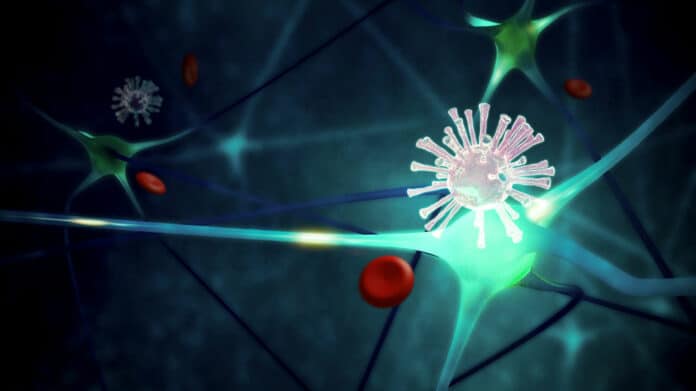Different SARS-CoV-2 variants cause various symptoms in patients. Researchers from Institut Pasteur and Université Paris Cité found that many of these variants, for the first time, can infect the central nervous system in an animal study. The study also showed that SARS-CoV-2 can infect human neurons in a lab setting and move within nerve cell projections called axons. This research was published on July 26, 2023, in Nature Communications.
As the virus evolved and new variants emerged, the neurological symptoms associated with SARS-CoV-2 changed. At the beginning of the COVID-19 pandemic, losing the sense of smell (anosmia) was a common symptom. However, it became less frequent with the Omicron/BA.1 variant. Does this symptom variation suggest that some variants have a stronger or weaker connection to the nervous system?
In their study, researchers from Institut Pasteur and Université Paris Cité showed that several SARS-CoV-2 variants, including the original Wuhan strain and the Gamma, Delta, and Omicron/BA.1 variants, can get into the central nervous system and stay there during the initial phase of the infection.
The study found that all these variants infect the olfactory bulb, a structure in the head that processes smell information before sending it to the brain.
Guilherme Dias de Melo, the first author of the study and researcher in the Institut Pasteur’s Lyssavirus, Epidemiology, and Neuropathology Unit, explains, “In this study, we demonstrated that infection of the olfactory bulb is common to all variants and not linked to any particular one, nor any particular clinical manifestation such as anosmia.”
The researchers also found a specific genetic sequence in the original COVID-19 connected to losing the sense of smell (anosmia). When this sequence, which makes the ORF7ab protein, is removed or shortened (which happens in some variants causing less anosmia), infected animals have a lower chance of losing their sense of smell, even if the virus still infects their neurons in the olfactory bulbs to the same extent.
Guilherme Dias de Melo said, “This suggests that anosmia and neuronal infection are two unrelated phenomena. If we follow this line of reasoning, it is quite possible that even an asymptomatic – and therefore clinically benign – infection is characterized by the spread of the virus in the nervous system.”
The researchers examined how SARS-CoV-2 reaches the olfactory bulb and found that neurons provide an ideal pathway. They used a unique in vitro cell culture system to observe human neurons organized in a specific way that allowed them to track how molecules move within the axon.
Through this method, the researchers discovered that once inside the neuron, the virus can travel in two directions within the axon: from the cell body to the axon terminals (anterograde movement) or from the axons to the cell body (retrograde approach).
The virus effectively uses the neuron’s natural mechanisms to move in both directions. The SARS-CoV-2 variants they studied, including the original Wuhan strain, Gamma, Delta, and Omicron/BA.1, can infect neurons in vitro and move along axons.
“In this study, we’ve found that SARS-CoV-2 has a tendency to infect the brain, and this appears to be a common feature among all the variants we looked at,” said Hervé Bourhy, who led the study at Institut Pasteur. “Our next step is to see if the virus can stick around in the brain after the initial infection in animals and whether it might cause long-term inflammation and symptoms like anxiety, depression, and brain fog, which are seen in cases of long COVID.”
Funding for this research came from the organizations mentioned: the French Foundation for Medical Research, ANRS-Emerging Infectious Diseases, and the Human Brain Project.
This research highlights the potential for SARS-CoV-2 to infect the brain through neuronal pathways and calls for further investigation into the virus’s persistence in the brain beyond the acute phase of infection. This may help in understanding the origins of long-term symptoms associated with COVID-19, such as anxiety, depression, and brain fog.
Journal reference:
- De Melo, G.D., Perraud, V., Alvarez, F. et al. Neuroinvasion and anosmia are independent phenomena upon infection with SARS-CoV-2 and its variants. Nature Communications. DOI: 10.1038/s41467-023-40228-7.
